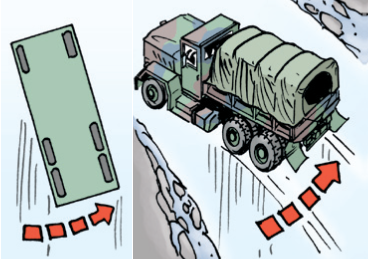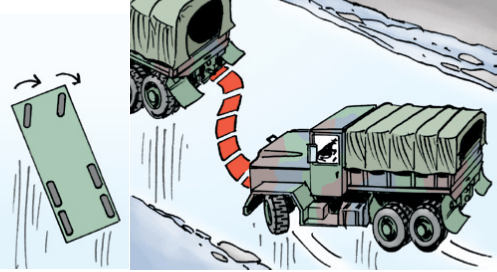Operators, winter driving presents unique challenges. The bottom line is that you need to be prepared for these challenges.
Use the guidance in the appropriate TM and these helpful tips to prevent problems down the road. Caution: Don’t forget that using a cell phone while driving is a no-go!
Speed
Steep hills, sharp curves and ice or snow-covered roads can mean trouble! So what’s your best defense? Adjust your speed to road conditions, allow yourself more time and be on the lookout for changing road conditions.
Skidding
What about skidding? Easy! Suppose that the rear of your truck is skidding to the right. What do you do?
 Rear of vehicle skidding to the right
Rear of vehicle skidding to the right
Remain calm and take your foot off the gas, then turn your steering wheel to the right, in the direction that your rear is skidding.
 Turn steering wheel in direction your rear is skidding
Turn steering wheel in direction your rear is skidding
Of course, if the truck is skidding to the left, then you’d do the opposite.
If driving a tractor trailer, steer away from the direction of the sliding trailer. Steer just enough to correct the skid and you’ll be fine.
What about curves and downgrades? Slow down before going into a curve or downgrade. Engine drag helps too. Just ease off the throttle.
Keep your eyes on the road for stranded motorists and vehicles, as well as drifts of snow, mud and ice.
Even if the road ahead looks clean, don’t be fooled. Slick, icy spots (black ice) form at the bottom of hills, on bridges, railroad crossings and in shaded areas in the winter.
Don't forget that bridges and overpasses freeze first! Cold air passes underneath them and freezes any moisture that’s on them.
Hills
What should you know about hills? When climbing a hill, momentum and traction are your friends. Just remember…
- If momentum is too slow for wheel speed, the result is lost traction and your vehicle’s tires will spin.
- If momentum is too fast for wheel speed, that also results in lost traction and the vehicle skids.
- If momentum and wheel speed are in tune, you’ll have tire traction and good control.
When travelling uphill, the more momentum you have, the less traction you’ll need to rely on.
It’s also a good idea to let the vehicles ahead of you make it to the top of the hill first. Then you won’t have to stop halfway up. And remember to keep your distance from other vehicles.
Try to get to the top of the hill in one uninterrupted run so that you’ve got enough momentum left to get your vehicle over the peak. This is especially helpful when pulling a trailer.
 Use momentum to get over peak
Use momentum to get over peak
Tires
Your tires are the only part of your vehicle gripping the surface of the road. So keep tires properly inflated and in good condition to improve traction.
Distribute loads evenly and place partial loads over the rear axle whenever possible. It’ll help your vehicle’s tires grip the road.
Avoid quick starts, sudden stops and sharp turns because they’ll cause you to lose traction.
Tire Chains
Why use tire chains? Tire chains improve traction on ice and packed snow, but only if they are correctly installed.
It’s important to use the right size and type of chain. Check your truck’s operator manual to determine which tire chain is required.
Here are some common tire chain NSNs and in most cases, this info is found on the additional authorization list (AAL) in the vehicle’s TM, in case your vehicle isn’t listed.
| Wheeled vehicle |
Tire size |
Chain assembly
NSN 2540- |
FMTV, MRAP,
HIMARS |
14.00x20 |
01-483-2930 |
| M-ATV, MMPV |
395x85R20 |
01-492-2989 |
HEMTT, PLS,
MRAP RG-33 |
16.00Rx20 |
01-152-7813 |
M1070,
M1070A1 HET |
16.00Rx20 |
01-152-7813 |
M915 FOV,
M916 FOV |
11R22.5 |
01-453-0497 |
M915 FOV,
M916 FOV |
10.00-22
OR
11x24.5 |
01-396-1914 |
| M939 FOV |
11x20 |
00-933-9022 |
It’s a great idea to look over TC 21-305-20,
Manual for the Wheeled Vehicle Operator (Jan 16), for an explanation on how to install tire chains.
Although tire chains are designed to fit snugly, you’ll want to tighten the chains by hand, instead of using tools. That prevents overtightening that can gouge tires.
If chains are still too loose after tightening by hand, use tire straps. By the way, some tire chain assemblies actually come with straps. Here’s some tire strap info:
| Size in inches |
Stretch in inches |
NSN 5340- |
| 15 |
20-30 |
01-029-9084 |
| 21 |
26-42 |
01-231-6015 |
| 31 |
36-42 |
01-029-9085 |
Shifting
What’s important about shifting gears in winter weather? Shifting during winter driving, especially downshifting, can affect traction. Try to make each shift as smooth as possible and be sure to follow the guidance in the appropriate TM because not all vehicles are the same.
Braking
What do you need to know about braking? Not all brake systems work alike. For example, if your vehicle has anti-lock brakes (ABS) you don’t want to pump them. Instead, apply a firm pressure while using the brakes. If you’ve got air brakes, apply a light steady pressure.
Don’t use the engine brake in icy conditions because it takes twelve (12) times the normal distance to come to a stop.
Never slam on your brakes in winter driving conditions because the front wheels can lock and you’ll lose control of steering.
The
US Army Combat Readiness Center has videos, lessons learned and other helpful info for driving tactical vehicles. You’ll also want to visit their
driver’s training toolbox.
Related Articles:
HMMWV: Preparing for Winter Driving